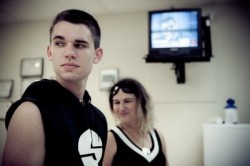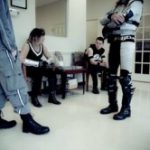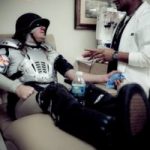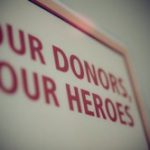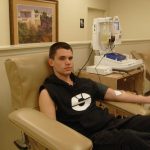Real-Life Superheroes – out of the comics onto the streets
There is a growing number of people serving their community. They dress and act like superheroes even though they don’t have any superpowers, they have one advantage over their comic-book idols, they are real!
These low-profile but visually arresting altruists go by such names as Fox Fire, Black Arrow, Polar Man, Civitron, and Knight Owl. They design their own costumes, ranging from outlandish all-in-one latex suits to motorcycle gear. They call themselves Real Life Superheroes, or Reals for short and they are united by a goal to make the world a better, safer place.
According to Chaim Lazaros, a film student by day and a Real-Life Superhero by the name of ‘Life’ by night, the movement is not entirely new: “We’ve seen several waves of activity among people calling themselves Real Life Superheroes for almost thirty years. I personally know some who have been doing it for twenty years. After the September 11 attacks and thanks to social networking sites on the internet there has been a resurgence of the superhero movement. There are currently about 250 active Reals all over the world.”
The enthusiasm for the US-based movement knows no borders and the causes the Reals adopt are as varied as the personas they assume. Super Barrio hails from Mexico where, rather than fight crime, he uses his image of red tights and matching wrestler’s mask to organise labour rallies, protests and file petitions. Ireland’s Captain Ozone conducts his environmental activism while dressed in a light blue body suit, complete with cape, while Canada’s Polar Man concerns himself with shovelling snow from the old people’s driveways, entertaining children and prowling the streets at nights keeping an eye out for vandals.
It may not exactly be glamourous work but it is conducted with a sense of style and panache that lifts the hearts of those being helped. In these times of economic hardship, when the world is looking at new leaders like heroes the Real-Life Superheroes are quietly but colourfully going about their business. They are helping stranded motorists, volunteering at soup kitchens and homeless shelters, participating in blood drives and fighting crime when the opportunity arises.
Since that day, Chaim has been making nightly patrols in his New York neighbourhood as Life. His uniform is street friendly: black trousers, black waistcoat, hat and eye mask. He freely admits his work is not exactly the stuff of comic-book storylines, there is no fighting villains and capturing criminals: “I realised that walking around in a uniform you don’t get to see bank robbers running out of banks with the alarms going off and purse snatchers that you have to punch in the face. But you do see a lot of homeless people. I started stocking up on water-bottles, grain bars, socks, vitamins and blankets. I would go out and interact with the homeless, bringing them things they may need and offering them a kind word.”
Chaim’s voluntary community work is not the only super-Samaritan endeavour carried out by the Real-Life Superheroes. In fact, the majority of what they do is community based. Chaim was part of a group that included Reals named Civitron and The Black Ghost that organised a trip to New Orleans to help with the fall out of Hurricane Katrina. They cleaned out, painted and repaired a school gym that was being used as a donations warehouse for victims of Katrina. Their work was noticed and duly rewarded by authorities when October 13 was declared ‘Day of Superheroes’.
If there is one thing we can learn from the comic-book legends, it’s that Superheroes usually have one weakness. For Chaim that weakness is a lack of defence training. He has had a couple of hairy moments while out patrolling, including an incident where he was held up with a broken bottle, that could have turned out worse. It makes his nightly patrols all the more dangerous for him. However, one Real that isn’t an issue for is Dark Guardian.
Chris Pollak, aka Dark Guardian, is a martial arts teacher by day and a black and red leather-clad Real by night. He explains his reason for becoming a Real-Life Superhero: “I’ve been doing this around six years. I started off without a costume, just going out doing a neighbourhood patrol, making sure everything was safe and everyone was good, it kind of evolved as it went along. I decided to pick up a costume and become a symbol, to try to become a really vibrant person to get a message to people that there is a hero in everyone and you can go out and make a difference.”
“I was always into comic books,” he continues. “I loved superheroes in my childhood and I never had real role models in my life. I always looked up to these characters and their ideals and I decided one day to make these ideals a reality. Now, I’m out doing it!”
Dark Guardian is also mostly concerned with homeless outreach and helping those that need it most. Along with Life, he also visits hospitals, in character, to bring presents to the sick children there. You would think that the work is laudable but sometimes some people don’t see it the same way.
“A lot of times you get mixed reactions. If I actually get the chance to talk to someone about it they are very receptive. Some love it, some think the costumes are a bit much but generally they understand we are doing good. People who don’t know about us or have bad misconceptions just think we are crazy!”
It’s a shame to think that in some quarters, including the media, the wrong perception of these do-gooders is portrayed. The Reals do their good work in their own time and at their own risk. It’s generally thankless work and if they want to dress up while doing it then that should be their prerogative.
Both Life and Dark Guardian hope their message of community work gets across. They hope that the number of Reals worldwide grows as more people are inspired by their acts.
“All it takes to be a Real-Life Superhero is to take on an iconic persona and go out and do some public good,” says Dark Guardian.
“We continue to inspire others to become Real Life Superheroes or get involved in their communities in other ways,” is the message from Life.
Community service has never been alluring. Voluntary work, by its very nature, usually attracts only the most altruistic people. The Real-Life Superheroes may raise eyes or generate sneers with the costumes they wear and the names they answer to, but their decency and hard work cannot be ignored, rather, it should be embraced. In a world where superheroes like Batman and Spiderman only exist on movie screens or in books these guys are the next best thing.
Ciaran Walsh for RT
http://www.russiatoday.com/Top_News/2009-02-17/Real-Life_Superheroes___out_of_the_comics_onto_the_streets.html?fullstory
